Enhancing Safety Training Performance Using Extended Reality: A Hybrid Delphi–AHP Multi-Attribute Analysis in a Type-2 Fuzzy Environment
Abstract
1. Introduction
- What are the most influential criteria for evaluating a trainee’s knowledge acquisition towards applying safety measures in their workplace? This question aims to understand the factors influencing the effectiveness of construction safety training. The effectiveness of training can be measured by understanding knowledge acquisition and retention among trainees. Insights gained from this understanding can help in designing highly effective construction safety training.
- To what extent do Extended Reality (XR) training methods impact criteria important for knowledge acquisition among trainees compared to traditional training methods? This question explores the limitations and advantages of using emerging technologies within the realm of XR visualizations for task information delivery. To cover technologies spanning the XR spectrum, both the extreme ends of the spectrum—Virtual Reality (VR) and Augmented Reality (AR)—have been addressed in this study. Understanding these technologies’ usability and limitations can enable the development of user-centric safety training sessions aimed at enhancing the performance of construction workers in a particular construction task.
- How does the decision of modelling criteria weight priorities change the outcome of the multi-attribute decision-making analysis? This question explores the robustness of the applied methodology in analysing the effectiveness of different criteria and training methodologies on the knowledge acquisition of trainees. Since the findings of this study depend on the method of the analysis employed, it is important to understand if the modeler’s decision to apportion different priority weights than those applied in this study would change the study’s outcome.
2. Literature Review
2.1. Knowledge Acquisition and Application towards Safe Working Practices
2.2. Implementation of XR-Based Training in AEC Industry
2.3. Multi-Attribute Decision-Making and Interval Type-2 Fuzzy Sets
3. Methodology
3.1. Interval Type-2 Fuzzy Sets
3.2. Criteria Selection
3.3. Interval Type-2 Fuzzy Delphi (IT2FD)
- Step 1: Significance value of sth sub-criteria as given by ith expert from the cohort of n experts
- Step 2: Defuzzification
- Step 3: Threshold Value
3.4. Training Administration and Data Collection
3.5. Interval Type-2 Fuzzy AHP (IT2F–AHP)
3.6. Sensitivity Analysis
4. Results
5. Discussion
6. Conclusions
Author Contributions
Funding
Institutional Review Board Statement
Informed Consent Statement
Data Availability Statement
Acknowledgments
Conflicts of Interest
Appendix A
| Criteria | IT2F Weight | Crisp Weight | Normalized Weight | Global Weight |
|---|---|---|---|---|
| Engagement | ||||
| AR | (0.25, 0.33, 0.5, 0.66; 1, 1) (0.25, 0.33, 0.49, 0.67; 0.8, 0.8) | 0.41 | 0.41 | 0.027 |
| VR | (0.3, 0.42, 0.64, 0.82; 1, 1) (0.31, 0.41, 0.64, 0.83; 0.8, 0.8) | 0.52 | 0.51 | 0.034 |
| Conventional | (0.06, 0.07, 0.1, 0.14; 1, 1) (0.06, 0.07, 0.1, 0.14; 0.8, 0.8) | 0.09 | 0.09 | 0.006 |
| User Interface | ||||
| AR | (0.29, 0.37, 0.52, 0.65; 1, 1) (0.3, 0.37, 0.51, 0.65; 0.8, 0.8) | 0.44 | 0.44 | 0.032 |
| VR | (0.32, 0.41, 0.55, 0.67; 1, 1) (0.33, 0.41, 0.55, 0.68; 0.8, 0.8) | 0.47 | 0.47 | 0.035 |
| Conventional | (0.06, 0.08, 0.11, 0.14; 1, 1) (0.06, 0.08, 0.1, 0.14; 0.8, 0.8) | 0.09 | 0.09 | 0.007 |
| Curiosity | ||||
| AR | (0.34, 0.47, 0.74, 0.96; 1, 1) (0.35, 0.47, 0.74, 0.98; 0.8, 0.8) | 0.60 | 0.58 | 0.032 |
| VR | (0.2, 0.26, 0.42, 0.57; 1, 1) (0.2, 0.26, 0.41, 0.57; 0.8, 0.8) | 0.35 | 0.34 | 0.018 |
| Conventional | (0.05, 0.07, 0.1, 0.13; 1, 1) (0.05, 0.06, 0.1, 0.13; 0.8, 0.8) | 0.08 | 0.08 | 0.004 |
| Variety | ||||
| AR | (0.35, 0.47, 0.71, 0.91; 1, 1) (0.35, 0.47, 0.71, 0.92; 0.8, 0.8) | 0.58 | 0.57 | 0.022 |
| VR | (0.19, 0.25, 0.39, 0.53; 1, 1) (0.19, 0.25, 0.39, 0.53; 0.8, 0.8) | 0.33 | 0.32 | 0.013 |
| Conventional | (0.07, 0.09, 0.13, 0.18; 1, 1) (0.07, 0.09, 0.13, 0.18; 0.8, 0.8) | 0.11 | 0.11 | 0.004 |
| Clarity | ||||
| AR | (0.27, 0.38, 0.61, 0.8; 1, 1) (0.27, 0.38, 0.61, 0.82; 0.8, 0.8) | 0.49 | 0.48 | 0.033 |
| VR | (0.23, 0.31, 0.49, 0.67; 1, 1) (0.24, 0.31, 0.49, 0.67; 0.8, 0.8) | 0.41 | 0.39 | 0.027 |
| Conventional | (0.08, 0.11, 0.16, 0.22; 1, 1) (0.08, 0.1, 0.16, 0.22; 0.8, 0.8) | 0.14 | 0.13 | 0.009 |
| Knowledge | ||||
| AR | (0.27, 0.38, 0.59, 0.76; 1, 1) (0.28, 0.38, 0.59, 0.78; 0.8, 0.8) | 0.48 | 0.47 | 0.016 |
| VR | (0.19, 0.25, 0.38, 0.52; 1, 1) (0.19, 0.24, 0.38, 0.52; 0.8, 0.8) | 0.32 | 0.31 | 0.011 |
| Conventional | (0.14, 0.18, 0.27, 0.37; 1, 1) (0.14, 0.18, 0.27, 0.37; 0.8, 0.8) | 0.23 | 0.22 | 0.008 |
| Visual Content | ||||
| AR | (0.25, 0.37, 0.63, 0.86; 1, 1) (0.26, 0.38, 0.63, 0.88; 0.8, 0.8) | 0.51 | 0.48 | 0.046 |
| VR | (0.21, 0.29, 0.48, 0.69; 1, 1) (0.21, 0.29, 0.48, 0.7; 0.8, 0.8) | 0.40 | 0.38 | 0.037 |
| Conventional | (0.08, 0.11, 0.18, 0.26; 1, 1) (0.08, 0.11, 0.17, 0.26; 0.8, 0.8) | 0.15 | 0.14 | 0.014 |
| Updated content | ||||
| AR | (0.19, 0.26, 0.42, 0.58; 1, 1) (0.19, 0.26, 0.42, 0.58; 0.8, 0.8) | 0.35 | 0.34 | 0.019 |
| VR | (0.14, 0.18, 0.28, 0.39; 1, 1) (0.14, 0.18, 0.28, 0.39; 0.8, 0.8) | 0.24 | 0.23 | 0.013 |
| Conventional | (0.25, 0.35, 0.56, 0.73; 1, 1) (0.25, 0.35, 0.55, 0.74; 0.8, 0.8) | 0.45 | 0.44 | 0.025 |
| Practicality | ||||
| AR | (0.28, 0.41, 0.66, 0.89; 1, 1) (0.29, 0.41, 0.66, 0.91; 0.8, 0.8) | 0.54 | 0.51 | 0.057 |
| VR | (0.21, 0.29, 0.47, 0.65; 1, 1) (0.21, 0.29, 0.47, 0.66; 0.8, 0.8) | 0.39 | 0.37 | 0.041 |
| Conventional | (0.07, 0.09, 0.15, 0.21; 1, 1) (0.07, 0.09, 0.14, 0.21; 0.8, 0.8) | 0.12 | 0.12 | 0.013 |
| Ease Understanding | ||||
| AR | (0.35, 0.48, 0.74, 0.95; 1, 1) (0.36, 0.48, 0.74, 0.96; 0.8, 0.8) | 0.60 | 0.59 | 0.054 |
| VR | (0.19, 0.25, 0.38, 0.52; 1, 1) (0.19, 0.24, 0.37, 0.52; 0.8, 0.8) | 0.32 | 0.31 | 0.028 |
| Conventional | (0.07, 0.08, 0.12, 0.16; 1, 1) (0.07, 0.08, 0.12, 0.16; 0.8, 0.8) | 0.10 | 0.10 | 0.009 |
| Conciseness | ||||
| AR | (0.34, 0.44, 0.65, 0.81; 1, 1) (0.34, 0.44, 0.64, 0.82; 0.8, 0.8) | 0.53 | 0.53 | 0.021 |
| VR | (0.2, 0.26, 0.38, 0.5; 1, 1) (0.21, 0.26, 0.38, 0.5; 0.8, 0.8) | 0.32 | 0.32 | 0.013 |
| Conventional | (0.1, 0.13, 0.18, 0.23; 1, 1) (0.1, 0.12, 0.18, 0.23; 0.8, 0.8) | 0.15 | 0.15 | 0.006 |
| Visualization | ||||
| AR | (0.34, 0.46, 0.71, 0.91; 1, 1) (0.34, 0.46, 0.71, 0.93; 0.8, 0.8) | 0.58 | 0.57 | 0.052 |
| VR | (0.21, 0.28, 0.43, 0.58; 1, 1) (0.21, 0.28, 0.43, 0.58; 0.8, 0.8) | 0.36 | 0.35 | 0.032 |
| Conventional | (0.06, 0.07, 0.1, 0.14; 1, 1) (0.06, 0.07, 0.1, 0.14; 0.8, 0.8) | 0.09 | 0.08 | 0.008 |
| Repetition | ||||
| AR | (0.29, 0.39, 0.58, 0.73; 1, 1) (0.3, 0.39, 0.57, 0.74; 0.8, 0.8) | 0.47 | 0.47 | 0.013 |
| VR | (0.23, 0.3, 0.43, 0.55; 1, 1) (0.23, 0.29, 0.43, 0.55; 0.8, 0.8) | 0.36 | 0.36 | 0.010 |
| Conventional | (0.12, 0.14, 0.21, 0.26; 1, 1) (0.12, 0.14, 0.2, 0.27; 0.8, 0.8) | 0.17 | 0.17 | 0.005 |
| Activity Completion | ||||
| AR | (0.3, 0.41, 0.6, 0.75; 1, 1) (0.31, 0.41, 0.6, 0.76; 0.8, 0.8) | 0.49 | 0.49 | 0.015 |
| VR | (0.25, 0.32, 0.47, 0.63; 1, 1) (0.25, 0.31, 0.47, 0.62; 0.8, 0.8) | 0.40 | 0.39 | 0.012 |
| Conventional | (0.08, 0.1, 0.15, 0.19; 1, 1) (0.08, 0.1, 0.14, 0.19; 0.8, 0.8) | 0.12 | 0.12 | 0.004 |
| Enjoyment | ||||
| AR | (0.34, 0.47, 0.71, 0.91; 1, 1) (0.35, 0.47, 0.71, 0.92; 0.8, 0.8) | 0.58 | 0.57 | 0.021 |
| VR | (0.22, 0.28, 0.43, 0.59; 1, 1) (0.22, 0.28, 0.43, 0.59; 0.8, 0.8) | 0.36 | 0.36 | 0.013 |
| Conventional | (0.05, 0.06, 0.09, 0.12; 1, 1) (0.05, 0.06, 0.09, 0.12; 0.8, 0.8) | 0.08 | 0.08 | 0.003 |
| Feedback | ||||
| AR | (0.34, 0.45, 0.65, 0.8; 1, 1) (0.35, 0.45, 0.65, 0.81; 0.8, 0.8) | 0.54 | 0.54 | 0.012 |
| VR | (0.21, 0.26, 0.38, 0.49; 1, 1) (0.21, 0.26, 0.37, 0.49; 0.8, 0.8) | 0.32 | 0.32 | 0.007 |
| Conventional | (0.11, 0.13, 0.17, 0.22; 1, 1) (0.11, 0.12, 0.17, 0.22; 0.8, 0.8) | 0.15 | 0.15 | 0.003 |
| Design | ||||
| AR | (0.32, 0.43, 0.65, 0.83; 1, 1) (0.32, 0.43, 0.65, 0.84; 0.8, 0.8) | 0.53 | 0.52 | 0.030 |
| VR | (0.24, 0.31, 0.46, 0.61; 1, 1) (0.24, 0.31, 0.46, 0.61; 0.8, 0.8) | 0.39 | 0.38 | 0.022 |
| Conventional | (0.07, 0.08, 0.11, 0.14; 1, 1) (0.07, 0.08, 0.11, 0.15; 0.8, 0.8) | 0.09 | 0.09 | 0.005 |
References
- Australia, S.W. Work-Related Traumatic Injury Fatalities, Australia. Available online: https://www.safeworkaustralia.gov.au/sites/default/files/2021-11/Work-related%20traumatic%20injury%20fatalities%20Australia%202020.pdf (accessed on 20 December 2022).
- Gharaie, E.; Lingard, H.; Cooke, T. Causes of Fatal Accidents Involving Cranes in the Australian Construction Industry. Constr. Econ. Build. 2015, 15, 1–12. [Google Scholar] [CrossRef]
- Kazan, E.; Usmen, M.A. Worker safety and injury severity analysis of earthmoving equipment accidents. J. Saf. Res. 2018, 65, 73–81. [Google Scholar] [CrossRef] [PubMed]
- Han, Y.; Yang, J.; Diao, Y.; Jin, R.; Guo, B.; Adamu, Z. Process and Outcome-based Evaluation between Virtual Reality-driven and Traditional Construction Safety Training. Adv. Eng. Inform. 2022, 52, 101634. [Google Scholar] [CrossRef]
- Rowen, A.; Grabowski, M.; Russell, D.W. The impact of work demands and operational tempo on safety Culture, motivation and perceived performance in safety critical systems. Saf. Sci. 2022, 155, 105861. [Google Scholar] [CrossRef]
- Shringi, A.; Arashpour, M.; Dwyer, T.; Prouzeau, A.; Li, H. Safety in off-site construction: Simulation of crane lifting operations using virtual reality (VR) and Building Information Models (BIM). J. Archit. Eng. 2023, 29, 04022035. [Google Scholar] [CrossRef]
- Lovreglio, R.; Gonzalez, V.; Feng, Z.; Amor, R.; Spearpoint, M.; Thomas, J.; Trotter, M.; Sacks, R. Prototyping virtual reality serious games for building earthquake preparedness: The Auckland City Hospital case study. Adv. Eng. Inform. 2018, 38, 670–682. [Google Scholar] [CrossRef]
- Wolf, M.; Teizer, J.; Wolf, B.; Bükrü, S.; Solberg, A. Investigating hazard recognition in augmented virtuality for personalized feedback in construction safety education and training. Adv. Eng. Inform. 2022, 51, 101469. [Google Scholar] [CrossRef]
- Moore, H.F.; Eiris, R.; Gheisari, M.; Esmaeili, B. Hazard Identification Training Using 360-Degree Panorama vs.Virtual Reality Techniques: A Pilot Study. In Proceedings of the Computing in Civil Engineering 2019: Visualization, Information Modeling, and Simulation, Atlanta, GA, USA, 17–19 June 2019; pp. 55–62. [Google Scholar]
- Pham, H.C.; Dao, N.N.; Pedro, A.; Le, Q.T.; Hussain, R.; Cho, S.; Park, C.S. Virtual field trip for mobile construction safety education using 360-degree panoramic virtual reality. Int. J. Eng. Educ. 2018, 34, 1174–1191. [Google Scholar]
- Eiris, R.; Gheisari, M.; Esmaeili, B. Desktop-based safety training using 360-degree panorama and static virtual reality techniques: A comparative experimental study. Autom. Constr. 2020, 109, 102969. [Google Scholar] [CrossRef]
- Zhang, H.; He, X.; Mitri, H. Fuzzy comprehensive evaluation of virtual reality mine safety training system. Saf. Sci. 2019, 120, 341–351. [Google Scholar] [CrossRef]
- Van Wyk, E.; De Villiers, R. Virtual reality training applications for the mining industry. In Proceedings of the AFRIGRAPH 2009: 6th International Conference on Computer Graphics, Virtual Reality, Visualisation and Interaction in Africa, Pretoria, South Africa, 4–6 February 2009; pp. 53–64. [Google Scholar]
- Patle, D.S.; Manca, D.; Nazir, S.; Sharma, S. Operator training simulators in virtual reality environment for process operators: A review. Virtual Real. 2019, 23, 293–311. [Google Scholar] [CrossRef]
- Keller, J.M. Motivational Design for Learning and Performance: The ARCS Model Approach, 1st ed.; Springer: New York, NY, USA, 2010. [Google Scholar] [CrossRef]
- Keller, J.M. Motivation and instructional design: A theoretical perspective. J. Instr. Dev. 1979, 2, 26–34. [Google Scholar] [CrossRef]
- Pandit, B.; Albert, A.; Patil, Y.; Al-Bayati, A.J. Impact of safety climate on hazard recognition and safety risk perception. Saf. Sci. 2019, 113, 44–53. [Google Scholar] [CrossRef]
- Teo, E.A.L.; Ling, F.Y.Y.; Chong, A.F.W. Framework for project managers to manage construction safety. Int. J. Proj. Manag. 2005, 23, 329–341. [Google Scholar] [CrossRef]
- Choudhry, R.M.; Fang, D. Why operatives engage in unsafe work behavior: Investigating factors on construction sites. Saf. Sci. 2008, 46, 566–584. [Google Scholar] [CrossRef]
- Choudhry, R.M. Behavior-based safety on construction sites: A case study. Accid. Anal. Prev. 2014, 70, 14–23. [Google Scholar] [CrossRef] [PubMed]
- Arashpour, M.; Golafshani, E.M.; Parthiban, R.; Lamborn, J.; Kashani, A.; Li, H.; Farzanehfar, P. Predicting individual learning performance using machine-learning hybridized with the teaching-learning-based optimization. Comput. Appl. Eng. Educ. 2022, 31, 83–99. [Google Scholar] [CrossRef]
- Neal, A.; Griffin, M.A.; Hart, P.M. The impact of organizational climate on safety climate and individual behavior. Saf. Sci. 2000, 34, 99–109. [Google Scholar] [CrossRef]
- Krath, J.; Schürmann, L.; von Korflesch, H.F.O. Revealing the theoretical basis of gamification: A systematic review and analysis of theory in research on gamification, serious games and game-based learning. Comput. Hum. Behav. 2021, 125, 106963. [Google Scholar] [CrossRef]
- Su, C.H.; Cheng, C.H. A mobile gamification learning system for improving the learning motivation and achievements. J. Comput. Assist. Learn. 2015, 31, 268–286. [Google Scholar] [CrossRef]
- Wu, C.H.; Liu, C.H.; Huang, Y.M. The exploration of continuous learning intention in STEAM education through attitude, motivation, and cognitive load. Int. J. STEM Educ. 2022, 9, 35. [Google Scholar] [CrossRef]
- Pando Cerra, P.; Fernández Álvarez, H.; Busto Parra, B.; Iglesias Cordera, P. Effects of Using Game-Based Learning to Improve the Academic Performance and Motivation in Engineering Studies. J. Educ. Comput. Res. 2022, 60, 1663–1687. [Google Scholar] [CrossRef]
- Hwang, G.J.; Chang, C.C.; Chien, S.Y. A motivational model-based virtual reality approach to prompting learners’ sense of presence, learning achievements, and higher-order thinking in professional safety training. Br. J. Educ. Technol. 2022, 53, 1343–1360. [Google Scholar] [CrossRef]
- Yang, F.; Miang Goh, Y. VR and MR technology for safety management education: An authentic learning approach. Saf. Sci. 2022, 148, 105645. [Google Scholar] [CrossRef]
- Hou, H.; Wu, H. Technology for real estate education and practice: A VR technology perspective. Prop. Manag. 2020, 38, 311–324. [Google Scholar] [CrossRef]
- Rokooei, S.; Shojaei, A.; Alvanchi, A.; Azad, R.; Didehvar, N. Virtual reality application for construction safety training. Saf. Sci. 2023, 157, 105925. [Google Scholar] [CrossRef]
- Yu, W.D.; Wang, K.C.; Wu, H.T. Empirical Comparison of Learning Effectiveness of Immersive Virtual Reality-Based Safety Training for Novice and Experienced Construction Workers. J. Constr. Eng. Manag. 2022, 148, 04022078. [Google Scholar] [CrossRef]
- Teizer, J.; Cheng, T.; Fang, Y. Location tracking and data visualization technology to advance construction ironworkers’ education and training in safety and productivity. Autom. Constr. 2013, 35, 53–68. [Google Scholar] [CrossRef]
- Park, C.S.; Kim, H.J. A framework for construction safety management and visualization system. Autom. Constr. 2013, 33, 95–103. [Google Scholar] [CrossRef]
- Li, H.; Lu, M.; Chan, G.; Skitmore, M. Proactive training system for safe and efficient precast installation. Autom. Constr. 2015, 49, 163–174. [Google Scholar] [CrossRef]
- Hou, L.; Chi, H.L.; Tarng, W.; Chai, J.; Panuwatwanich, K.; Wang, X. A framework of innovative learning for skill development in complex operational tasks. Autom. Constr. 2017, 83, 29–40. [Google Scholar] [CrossRef]
- Shi, Y.; Du, J.; Ahn, C.R.; Ragan, E. Impact assessment of reinforced learning methods on construction workers’ fall risk behavior using virtual reality. Autom. Constr. 2019, 104, 197–214. [Google Scholar] [CrossRef]
- Habibnezhad, M.; Shayesteh, S.; Jebelli, H.; Puckett, J.; Stentz, T. Comparison of ironworker’s fall risk assessment systems using an immersive biofeedback simulator. Autom. Constr. 2021, 122, 103471. [Google Scholar] [CrossRef]
- Ouyang, Y.; Luo, X. Differences between inexperienced and experienced safety supervisors in identifying construction hazards: Seeking insights for training the inexperienced. Adv. Eng. Inform. 2022, 52, 101602. [Google Scholar] [CrossRef]
- Guo, H.L.; Li, H.; Li, V. VP-based safety management in large-scale construction projects: A conceptual framework. Autom. Constr. 2013, 34, 16–24. [Google Scholar] [CrossRef]
- Li, H.; Chan, G.; Skitmore, M. Multiuser Virtual Safety Training System for Tower Crane Dismantlement. J. Comput. Civ. Eng. 2012, 26, 638–647. [Google Scholar] [CrossRef]
- Choi, M.; Ahn, S.; Seo, J. VR-Based investigation of forklift operator situation awareness for preventing collision accidents. Accid. Anal. Prev. 2020, 136, 105404. [Google Scholar] [CrossRef]
- Adami, P.; Rodrigues, P.B.; Woods, P.J.; Becerik-Gerber, B.; Soibelman, L.; Copur-Gencturk, Y.; Lucas, G. Effectiveness of VR-based training on improving construction workers’ knowledge, skills, and safety behavior in robotic teleoperation. Adv. Eng. Inform. 2021, 50, 101431. [Google Scholar] [CrossRef]
- Albert, A.; Hallowell, M.R.; Kleiner, B.; Chen, A.; Golparvar-Fard, M. Enhancing construction hazard recognition with high-fidelity augmented virtuality. J. Constr. Eng. Manag. 2014, 140, 04014024. [Google Scholar] [CrossRef]
- Perlman, A.; Sacks, R.; Barak, R. Hazard recognition and risk perception in construction. Saf. Sci. 2014, 64, 22–31. [Google Scholar] [CrossRef]
- Dzeng, R.-J.; Lin, C.-T.; Fang, Y.-C. Using eye-tracker to compare search patterns between experienced and novice workers for site hazard identification. Saf. Sci. 2016, 82, 56–67. [Google Scholar] [CrossRef]
- Namian, M.; Albert, A.; Zuluaga, C.M.; Behm, M. Role of Safety Training: Impact on Hazard Recognition and Safety Risk Perception. J. Constr. Eng. Manag. 2016, 142, 04016073. [Google Scholar] [CrossRef]
- Shringi, A.; Arashpour, M.; Golafshani, E.M.; Rajabifard, A.; Dwyer, T.; Li, H. Efficiency of VR-Based Safety Training for Construction Equipment: Hazard Recognition in Heavy Machinery Operations. Buildings 2022, 12, 2084. [Google Scholar] [CrossRef]
- Eiris, R.; Gheisari, M.; Esmaeili, B. PARS: Using Augmented 360-Degree Panoramas of Reality for Construction Safety Training. Int. J. Environ. Res. Public Health 2018, 15, 2452. [Google Scholar] [CrossRef] [PubMed]
- Goulding, J.; Nadim, W.; Petridis, P.; Alshawi, M. Construction industry offsite production: A virtual reality interactive training environment prototype. Adv. Eng. Inform. 2012, 26, 103–116. [Google Scholar] [CrossRef]
- Kazar, G.; Comu, S. Effectiveness of Serious Games for Safety Training: A Mixed Method Study. J. Constr. Eng. Manag. 2021, 147, 04021091. [Google Scholar] [CrossRef]
- Zadeh, L.A. Fuzzy sets. Inf. Control. 1965, 8, 338–353. [Google Scholar] [CrossRef]
- Zadeh, L.A. The concept of a linguistic variable and its application to approximate reasoning-I. Inf. Sci. 1975, 8, 199–249. [Google Scholar] [CrossRef]
- Mendel, J.M.; John, R.I.; Liu, F. Interval type-2 fuzzy logic systems made simple. IEEE Trans. Fuzzy Syst. 2006, 14, 808–821. [Google Scholar] [CrossRef]
- Abbasinia, M.; Mohammadfam, I. Identifying, evaluating and prioritizing the causes of occupational accidents in the construction industry using fuzzy AHP and fuzzy TOPSIS. Work 2022, 72, 933–940. [Google Scholar] [CrossRef]
- Mohandes, S.R.; Durdyev, S.; Sadeghi, H.; Mahdiyar, A.; Hosseini, M.R.; Banihashemi, S.; Martek, I. Towards enhancement in reliability and safety of construction projects: Developing a hybrid multi-dimensional fuzzy-based approach. Eng. Constr. Archit. Manag. 2022. [Google Scholar] [CrossRef]
- Basahel, A.; Taylan, O. Using fuzzy AHP and fuzzy TOPSIS approaches for assessing safety conditions at worksites in construction industry. Int. J. Saf. Secur. Eng. 2016, 6, 728–745. [Google Scholar] [CrossRef]
- Zhu, G.N.; Ma, J.; Hu, J. A fuzzy rough number extended AHP and VIKOR for failure mode and effects analysis under uncertainty. Adv. Eng. Inform. 2022, 51, 101454. [Google Scholar] [CrossRef]
- Bourhim, E.M.; Cherkaoui, A. Efficacy of Virtual Reality for Studying People’s Pre-evacuation Behavior under Fire. Int. J. Hum. Comput. Stud. 2020, 142, 102484. [Google Scholar] [CrossRef]
- Mohandes, S.R.; Zhang, X. Towards the development of a comprehensive hybrid fuzzy-based occupational risk assessment model for construction workers. Saf. Sci. 2019, 115, 294–309. [Google Scholar] [CrossRef]
- Patel, D.A.; Jha, K.N. Developing a Process to Evaluate Construction Project Safety Hazard Index Using the Possibility Approach in India. J. Constr. Eng. Manag. 2017, 143, 04016081. [Google Scholar] [CrossRef]
- Zhang, F.; Ju, Y.; Santibanez Gonzalez, E.D.R.; Wang, A. SNA-based multi-criteria evaluation of multiple construction equipment: A case study of loaders selection. Adv. Eng. Inform. 2020, 44, 101056. [Google Scholar] [CrossRef]
- Yaşli, F.; Bolat, B. A novel risk analysis approach for occupational safety using Bayesian Network and interval type-2 fuzzy sets: The case of underground mining. J. Intell. Fuzzy Syst. 2022, 42, 265–282. [Google Scholar] [CrossRef]
- Dhalmahapatra, K.; Maiti, J.; Krishna, O.B. Assessment of virtual reality based safety training simulator for electric overhead crane operations. Saf. Sci. 2021, 139, 105241. [Google Scholar] [CrossRef]
- Dalkey, N. An experimental study of group opinion: The Delphi method. Futures 1969, 1, 408–426. [Google Scholar] [CrossRef]
- Karsak, E.E. Fuzzy multiple objective decision making approach to prioritize design requirements in quality function deployment. Int. J. Prod. Res. 2004, 42, 3957–3974. [Google Scholar] [CrossRef]
- Li, S.; Tang, D.; Yang, J.; Wang, Q.; Ullah, I.; Zhu, H. A novel approach for capturing and evaluating dynamic consumer requirements in open design. Adv. Eng. Inform. 2019, 39, 95–111. [Google Scholar] [CrossRef]
- Ma, Z.; Shao, C.; Ma, S.; Ye, Z. Constructing road safety performance indicators using fuzzy delphi method and grey delphi method. Expert Sys. Appl. 2011, 38, 1509–1514. [Google Scholar] [CrossRef]
- Liu, B.; Shen, M.; Ma, Q. Application of fuzzy analytic network process in risk analysis for construction of highway mountain tunnel. Yanshilixue Yu Gongcheng Xuebao/Chin. J. Rock Mech. Eng. 2014, 33, 2861–2869. [Google Scholar]
- Australia, S.W. Preventing Falls in Housing Construction: Code of Practice; Safe Work Australia: Canberra, Australia, 2016. [Google Scholar]
- Unity Technologies. Unity3D 2021.3.19f1. Windows. 2022. Available online: https://unity.com/releases/editor/whats-new/2021.3.19 (accessed on 23 February 2023).
- Kahraman, C.; Öztayşi, B.; Uçal Sari, I.; Turanoǧlu, E. Fuzzy analytic hierarchy process with interval type-2 fuzzy sets. Knowl. Based Syst. 2014, 59, 48–57. [Google Scholar] [CrossRef]
- Murre, J.M.J.; Dros, J. Replication and Analysis of Ebbinghaus’ Forgetting Curve. PLoS ONE 2015, 10, e0120644. [Google Scholar] [CrossRef]
- Forcael, E.; Ferrari, I.; Opazo-Vega, A.; Pulido-Arcas, J.A. Construction 4.0: A Literature Review. Sustainability 2020, 12, 9755. [Google Scholar] [CrossRef]
- Dickinson, J.K.; Woodard, P.; Canas, R.; Ahamed, S.; Lockston, D. Game-based trench safety education: Development and lessons learned. Electron. J. Inf. Technol. Constr. 2011, 16, 119–134. [Google Scholar]
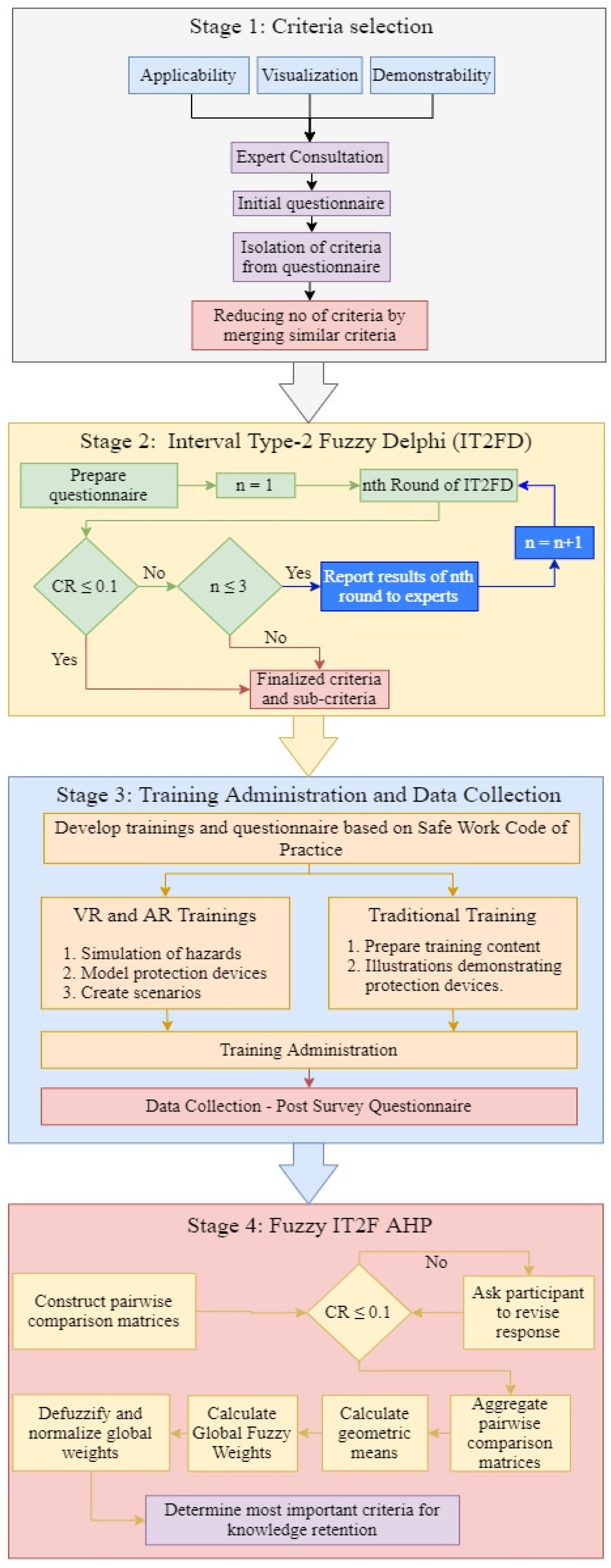
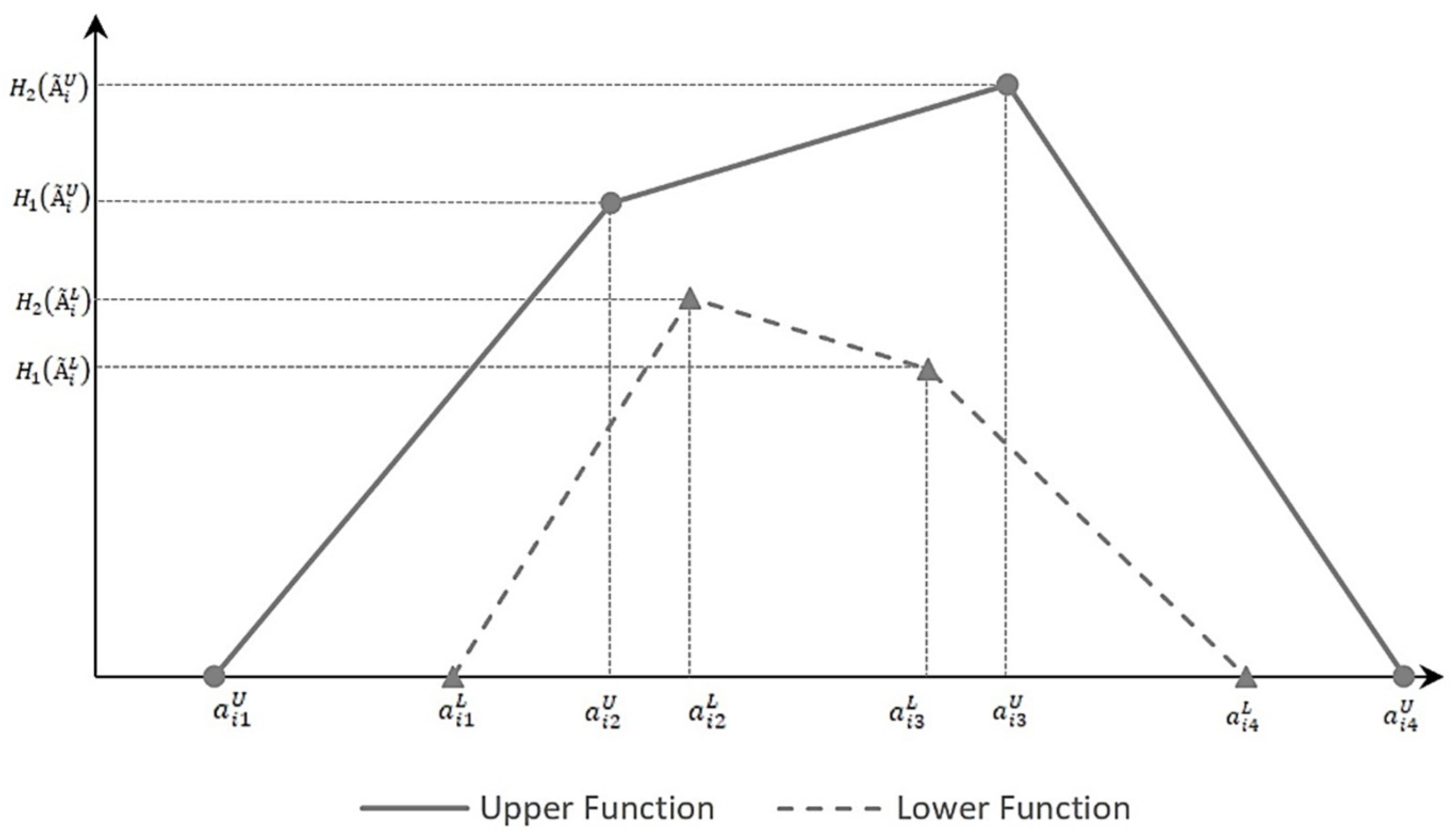
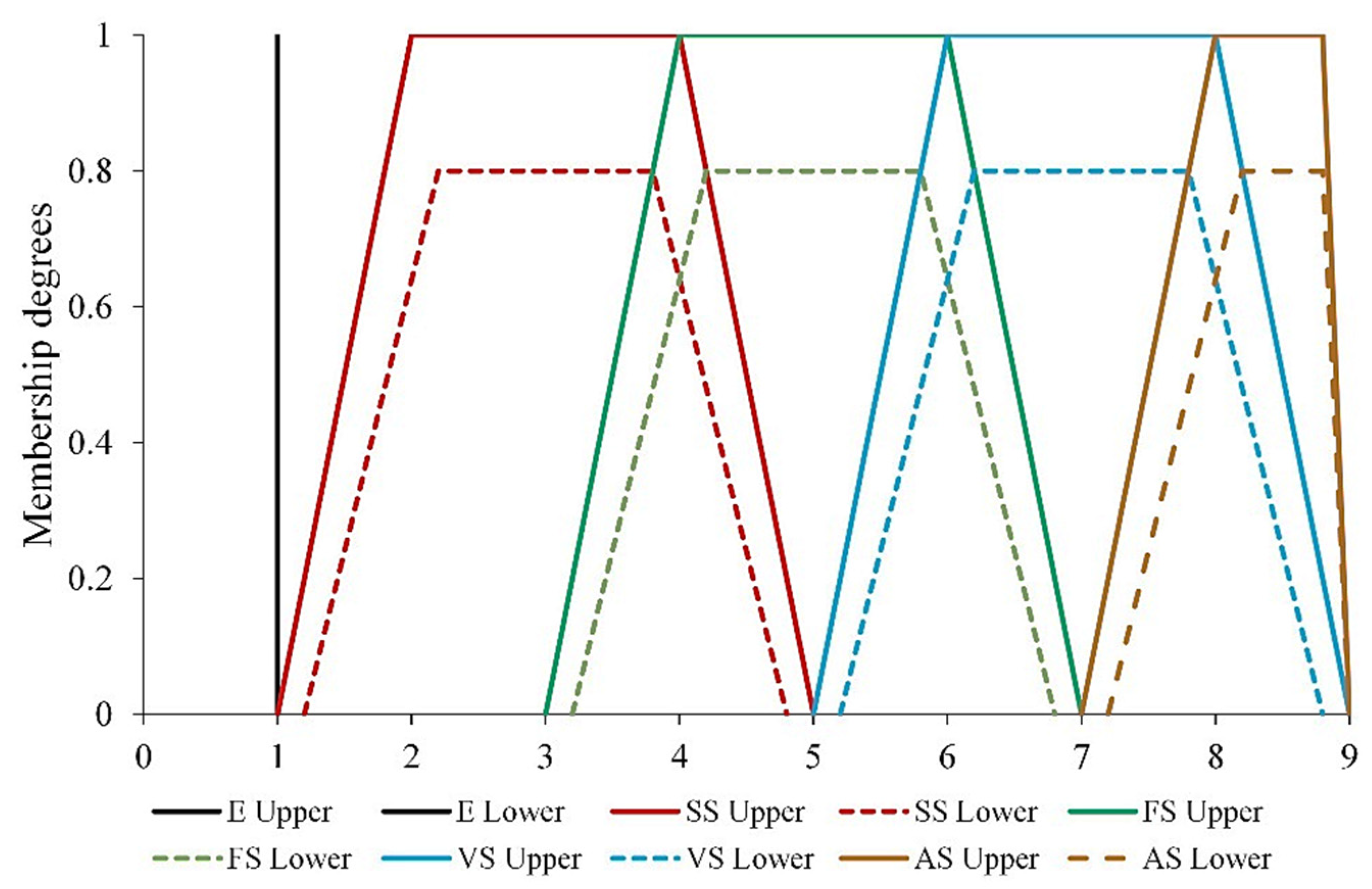
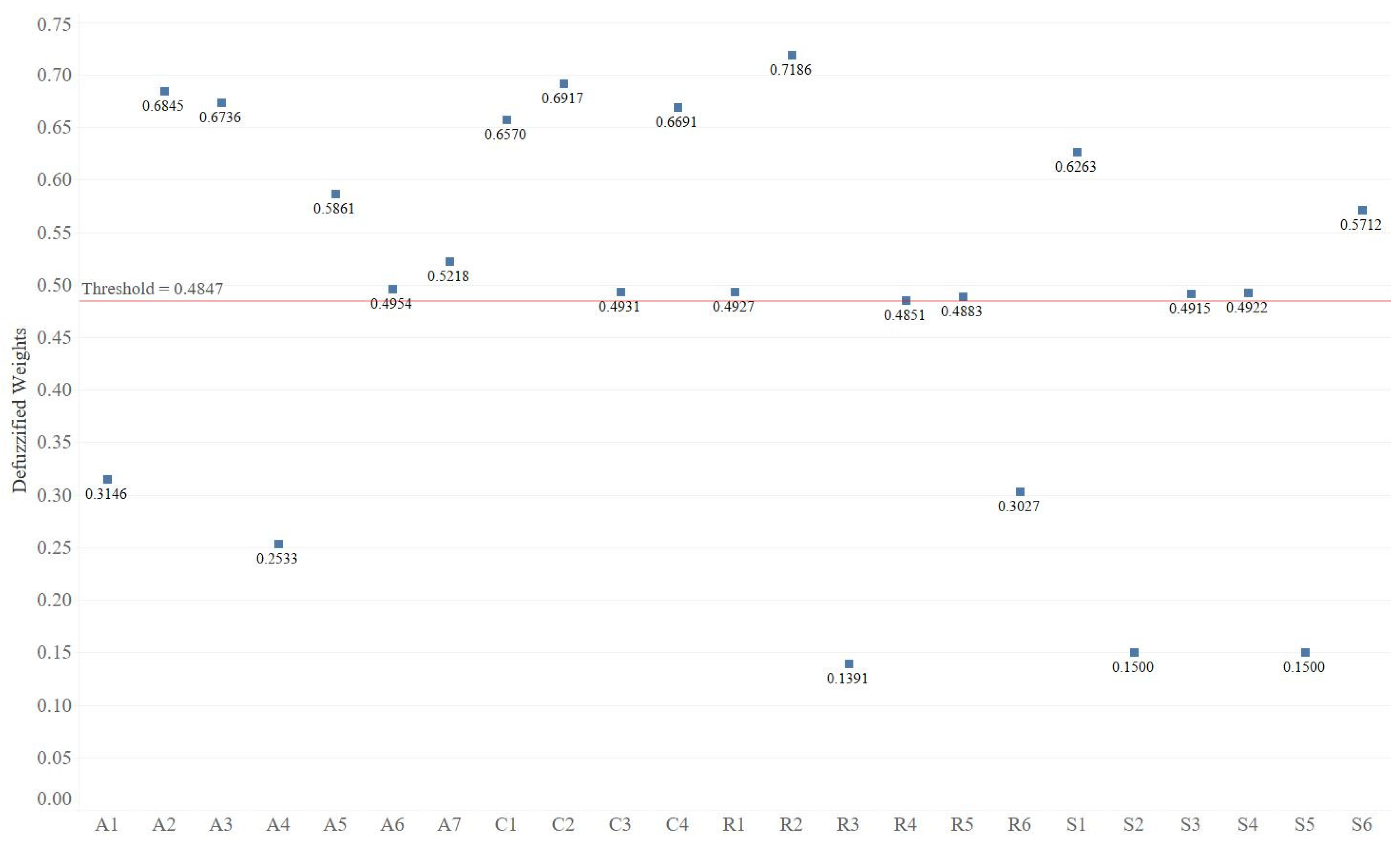
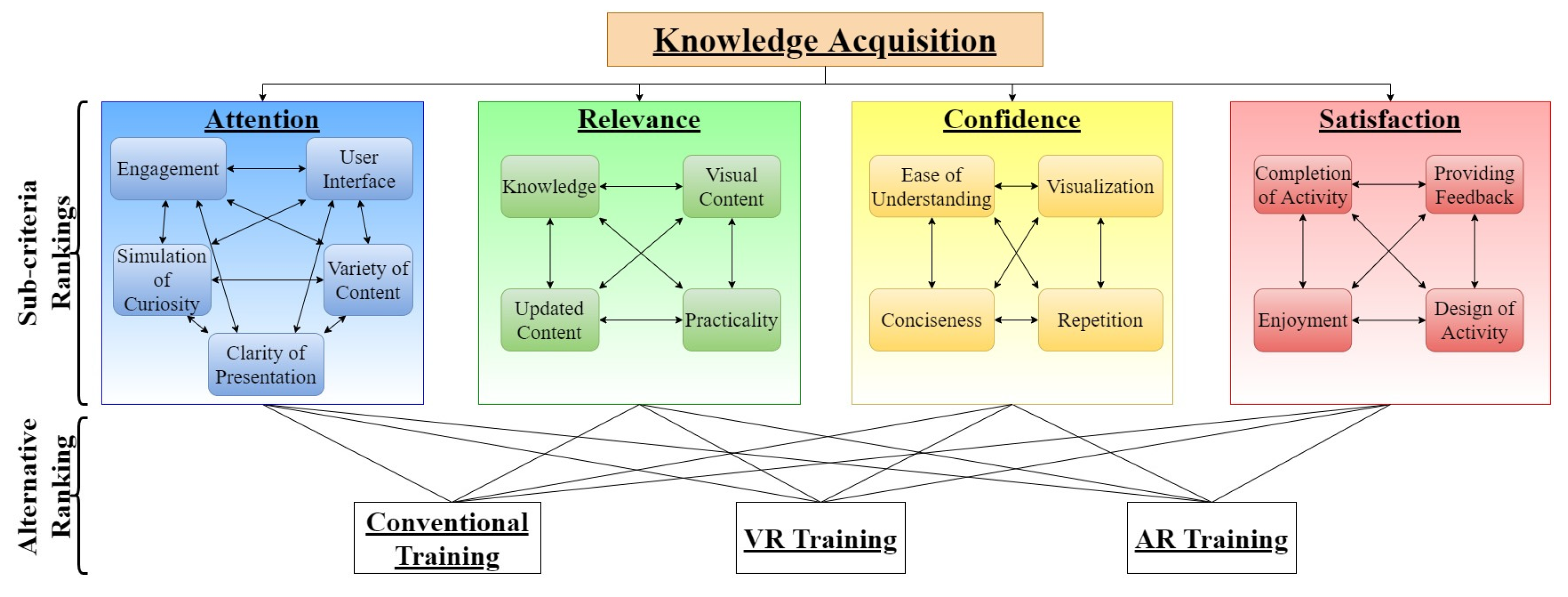


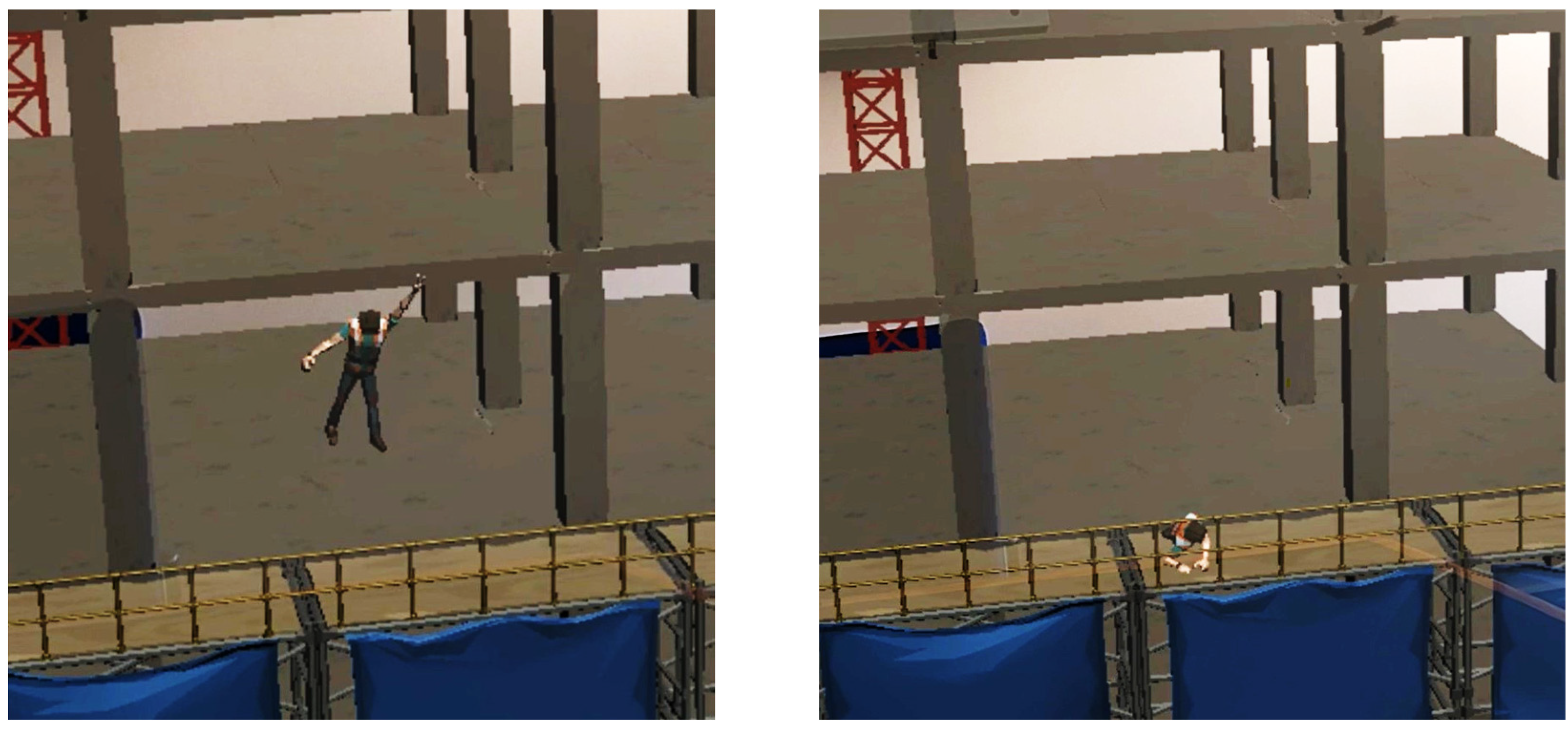
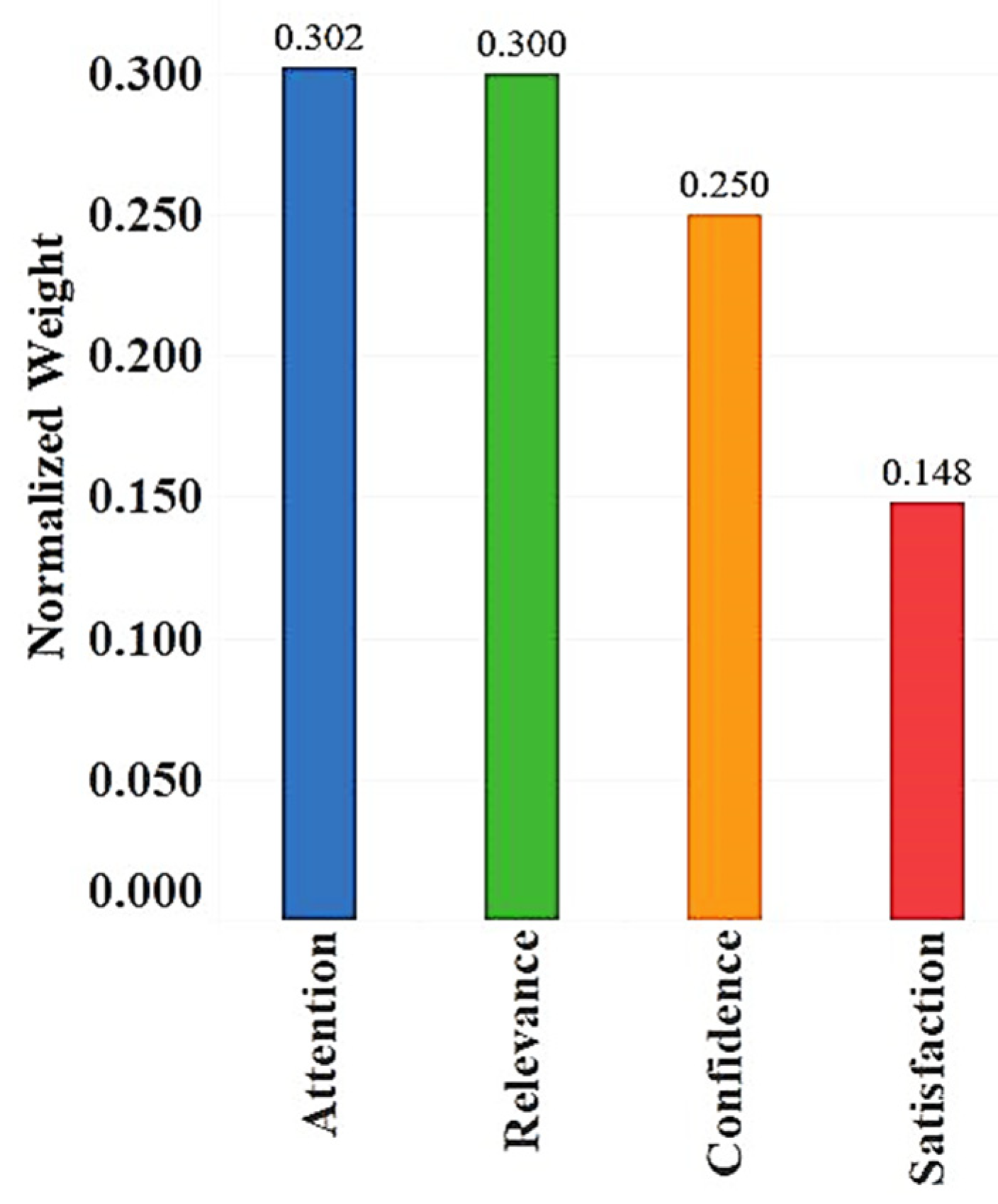
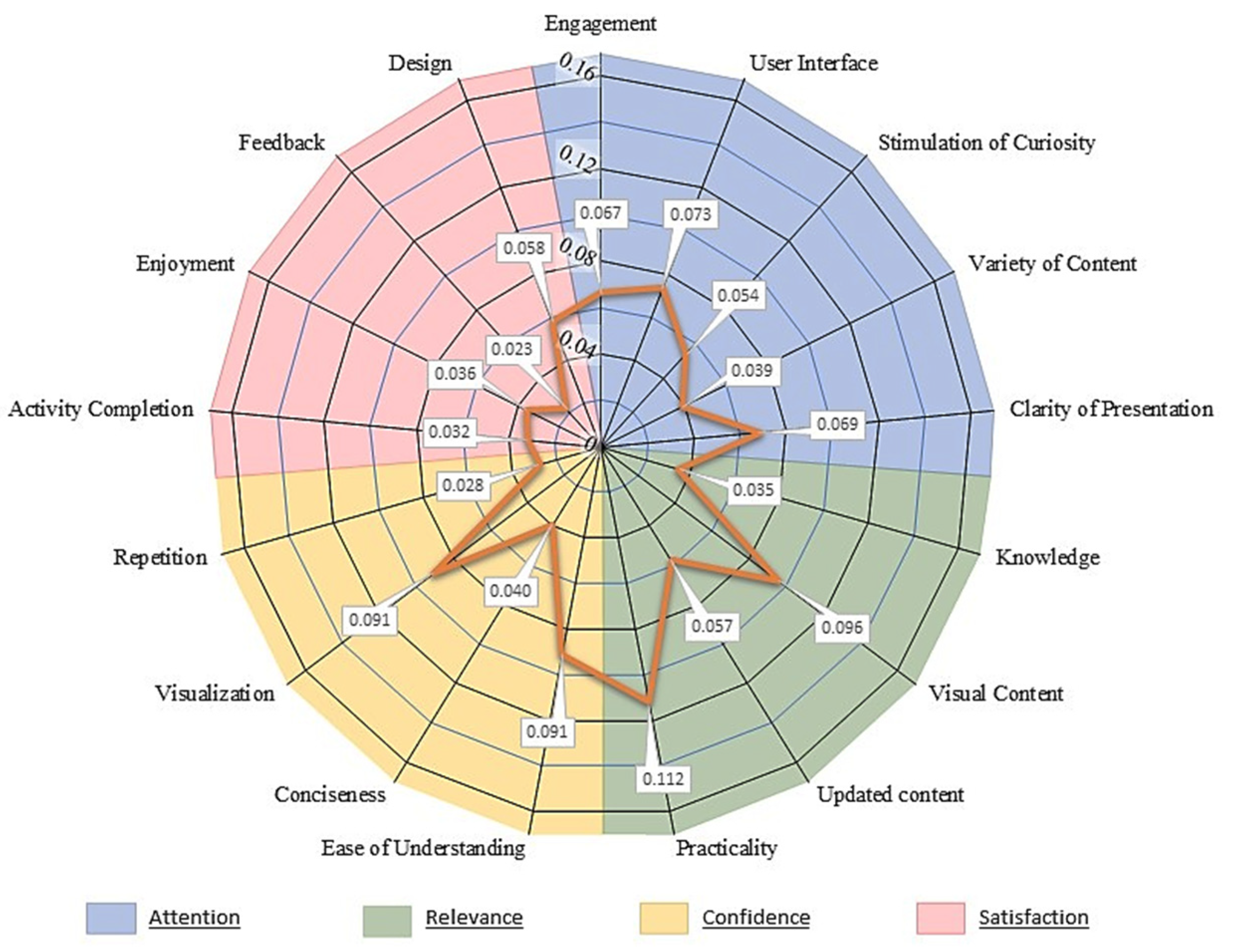
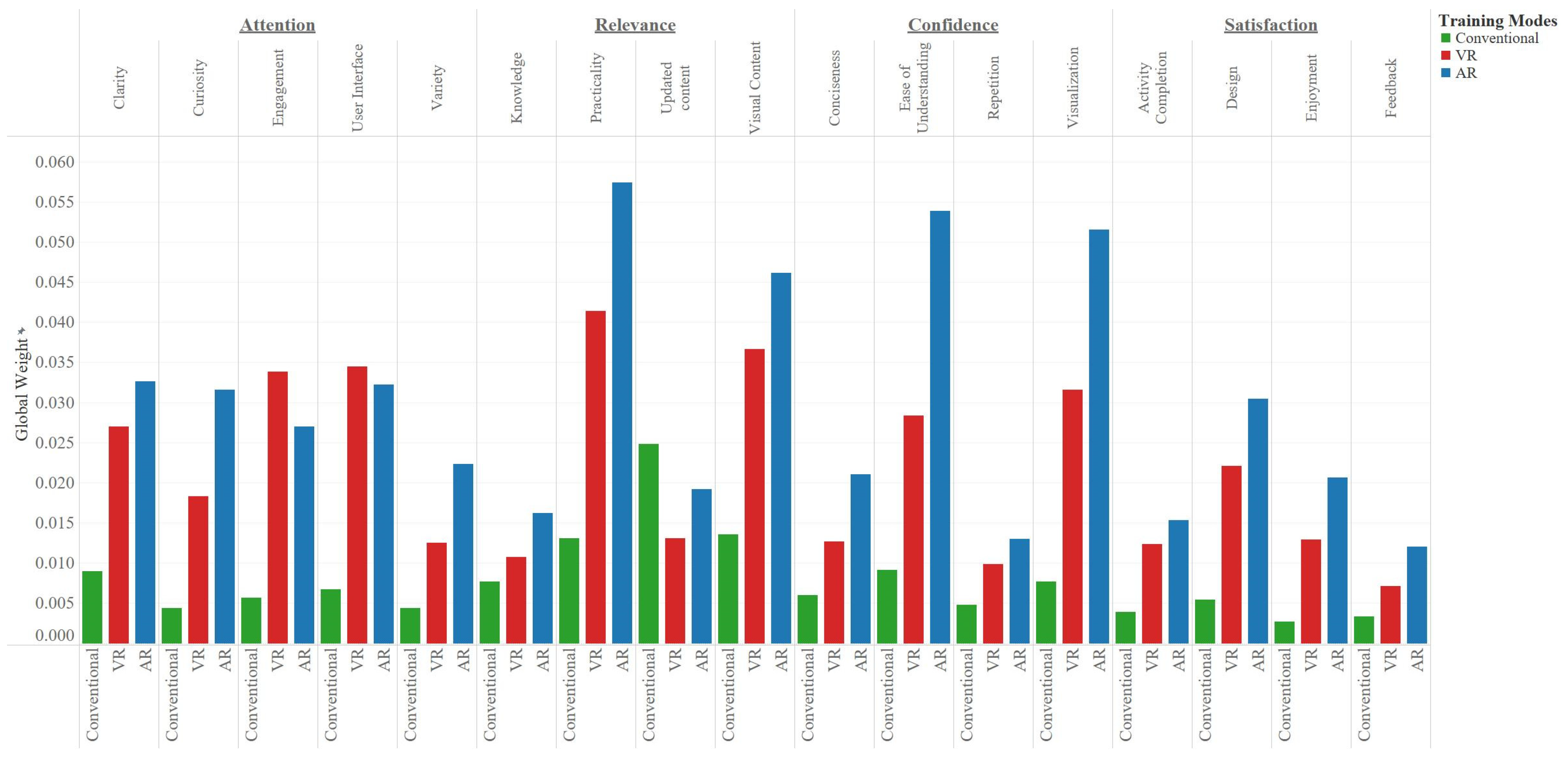
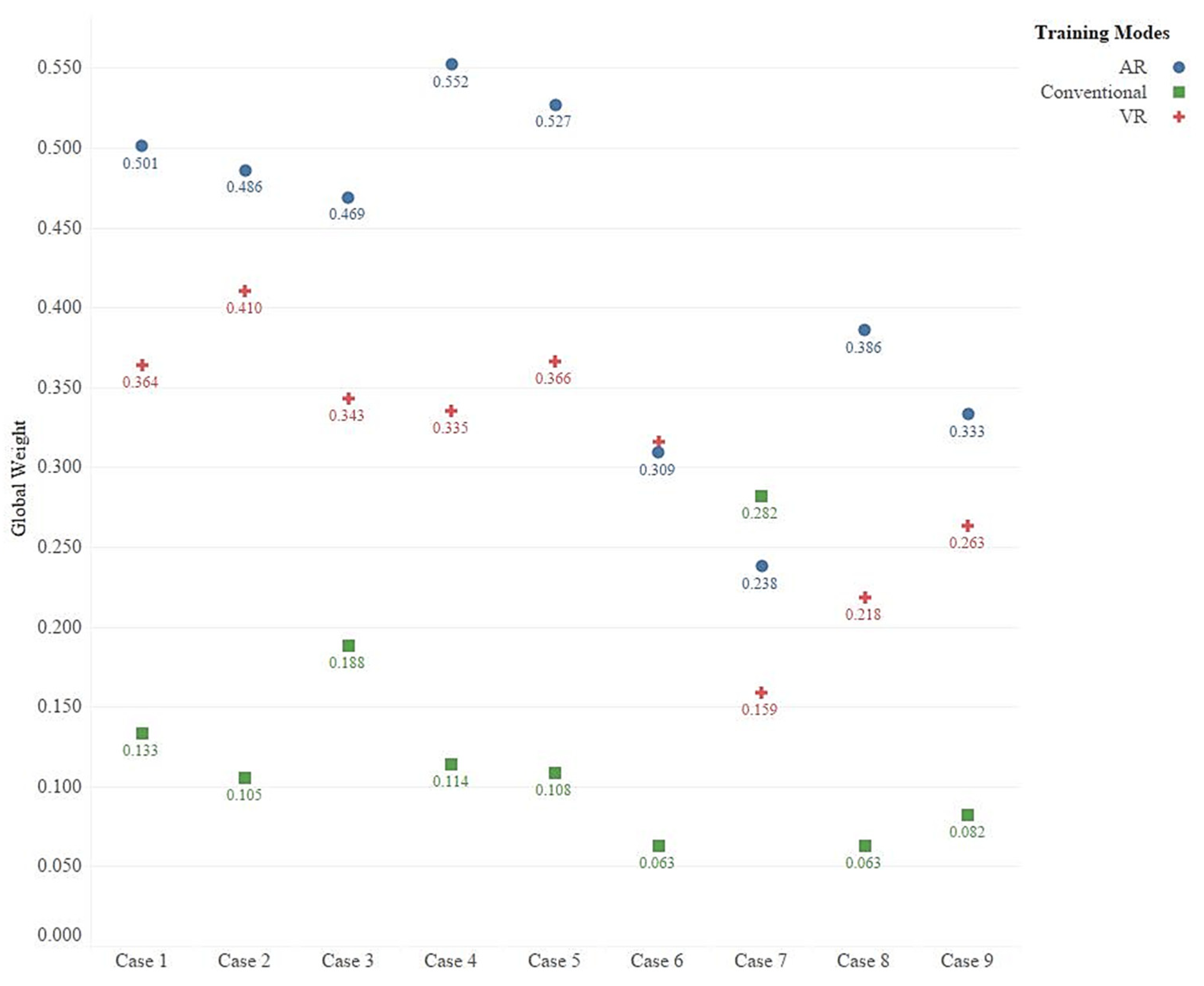
| Reference | Area of Application | Experiment Setup | Visualization Technology | Factors Analysed | Data Collection | Analysis Methods |
|---|---|---|---|---|---|---|
| [8] | Hazard recognition performance | High-risk brown-field construction work | VR HMD | Hazard Identification, safety behaviour | System feedback, survey (in gameplay) | Descriptive statistics |
| [11] | Hazard identification | Construction worksite | VR (LCD) | Presence, Hazard Identification | System feedback, Survey | Nonparametric Mann-Whitney U and Kruskal-Wallis, in conjunction with Dunn post hoc tests |
| [28] | Incident Investigation | VR (LCD) and Traditional (Recorded video) | Perceived Effectiveness, Motivation (ARCS) | Survey | Descriptive statistics (t-test) | |
| [30] | Impact of VR training | Roofing tasks | VR HMD | Accident causality, VR Effectiveness and VR Engagement | In-game survey | Descriptive statistics |
| [31] | Learning effectiveness of VR training | Safety training retention | VR HMD | Effectiveness of training based on experience, personality and job position | System feedback (in gameplay) | Descriptive statistics (MANOVA) |
| [32] | Safety training in workshop environment | Assembly of steel structures in workshop | VR without Headset | Worker Productivity | Survey and system | Simple statistical analysis |
| [33] | On-site worker training | Fall from height | VR (BIM), AR | Hazard Identification | Survey | Statistical Average of Q&A Performance |
| [34] | On-site work training | Struck by and fall hazards in precast façade installation | VR Headset | Training efficiency (Time) | System feedback | Scoring comparison + simple statistical analysis of likert scale feedback |
| [35] | Productivity training | LNG plant maintenance | VR and AR | Productivity and Learning | System feedback, Survey | t-test |
| [36] | Walking behaviour on site | Plank across buildings | VR headset + Kinect | Safety behaviour | System feedback | ANOVA |
| [37] | Fall from height (Risk evaluation) | Gait analysis of Ironworkers | VR HMD | Postural Control for fall analysis | Motion trackers | Descriptive statistics (t-test, Mann-whitney U) |
| [38] | Hazard recognition performance | Construction worksite | VR HMD | Hazard Identification | System feedback (in gameplay) | Descriptive statistics (t-test) |
| [39] | Tower crane dismantlement | Tower crane dismantlement | VR Headset + Keyboard + Nintendo Wii | Training efficiency | System feedback | Scoring comparison + simple statistical analysis of likert scale feedback |
| [40] | Tower crane lifting operation | Hook attachment to load | VR (LCD) + Keyboard + Nintendo Wii | Safety Performance | System feedback | Descriptive statistics |
| [41] | Forklift operations | Forklift operations | VR HMD | Situational Awareness | System feedback, survey | ANOVA |
| [42] | Machinery operation | Demolition robot operation | VR HMD | Knowledge acquisition, safety behaviour & operational skills | System feedback with controller and VR treadmill, survey | Descriptive statistics (ANOVA), Grounded theory (Qualitative) |
| [43] | Hazard Identification in VR | Industrial operations (Maintenance and Construction) | VR | Hazard Recognition | System feedback | t-test of HR Index |
| [44] | Hazard Identification in VR | Multiple hazards | VR withour Headset | Hazard Identification accuracy | System feedback | ANOVA |
| [45] | Hazard Identification in VR | Multiple hazards | VR HMD + Eye Tracker | Hazard Identification accuracy, miss rate, and time | System feedback | Simple statistical analysis |
| [46] | Hazard identification | - | - | Hazard identification and Safety risk perception | Surveys | t-test of HR Index |
| [47] | Hazard identification | Construction worksite | VR (LCD) | Usability and Realism, Hazard Identification | System feedback, Survey | Descriptive statistics |
| [48] | Safety Management | Safety manager training | VR LCD | Hazard Identification | User feedback for “Use Case” development | Observational analysis |
| [49] | Safety Education | Basic occupational safety and health-related information | VR LCD | Effectiveness of safety training | Survey | ANOVA |
| Reference | Context of Application | Analysis Methods |
|---|---|---|
| [12] | Evaluation of VR mine safety training system by ranking the components of the system using interval type-2 fuzzy AHP. | Interval Type-2 Fuzzy AHP |
| [54] | Analysing the causes of accidents by selecting and ranking the causes grouped under governance, environmental, and individual factors. | Fuzzy AHP, Fuzzy TOPSIS |
| [55] | Five-dimensional safety risk assessment for evaluating project safety risks using fuzzy AHP and fuzzy TOPSIS. | Fuzzy AHP, Fuzzy TOPSIS |
| [56] | Use of fuzzy AHP and fuzzy TOPSIS for the assessment of workplace safety conditions. | Fuzzy AHP, Fuzzy TOPSIS |
| [57] | Ranking failure modes for risk assessment based on a failure mode effects analysis with fuzzy rough numbers and VIKOR. | Fuzzy rough number VIKOR |
| [58] | Evaluation of system and user interfaces of virtual fire evacuation training using a fuzzy AHP analysis | Fuzzy AHP |
| [59] | Using a fuzzy Delphi and fuzzy BWM for construction workers’ risk assessments | Fuzzy Delphi, Fuzzy BWM |
| [60] | Development of a project hazard index using fuzzy AHP for a construction safety evaluation based on the hazardous trades involved. | Fuzzy AHP |
| [61] | Use of a fuzzy AHP to rank equipment based on selected criteria for appropriate loader selection | Fuzzy AHP |
| [62] | The development of occupational safety risk analysis methodology using a Bayesian network and interval yype-2 fuzzy sets. | Interval Type-2 Fuzzy Analysis |
| [63] | The assessment of VR simulator effectiveness by a fuzzy analysis of presence, usability, and sickness during virtual training. | Interval Type-2 Fuzzy AHP |
| [66] | Using a fuzzy Delphi to evaluate customers’ requirements in open design. | Fuzzy Delphi |
| [67] | The evaluation of safety perception of experts using a fuzzy Delphi to derive safety performance indicators. | Fuzzy Delphi |
| [68] | Use of a fuzzy ANP for the risk evaluation of tunnelling project. | Fuzzy ANP |
| Linguistic Variables | Trapezoidal Interval Type-2 Fuzzy Scales |
|---|---|
| Absolutely Strong (AS) | ((7, 8, 9, 9; 1, 1), (7.2, 8.2, 8.8, 9; 0.8, 0.8)) |
| Very Strong (VS) | ((5, 6, 8, 9; 1, 1), (5.2, 6.2, 7.8, 8.8; 0.8, 0.8)) |
| Fairly Strong (FS) | ((3, 4, 6, 7; 1, 1), (3.2, 4.2, 5.8, 6.8; 0.8, 0.8)) |
| Slightly Strong (SS) | ((1, 2, 4, 5; 1, 1), (1.2, 2.2, 3.8, 4.8; 0.8, 0.8)) |
| Exactly Equal (E) | ((1, 1, 1, 1; 1, 1), (1, 1, 1, 1; 1, 1)) |
| If factor i has one of the above linguistic variables assigned to it when compared with factor j, then j has the reciprocal value compared with i. | Reciprocals of above |
| Attention | |||
| IMMS Factor | Attention Related Questions | Keyword (Sub Criterion) | Unique/ Duplicate |
| 02A01 | Use of extended reality application for this exercise got my attention | Use | Unique |
| 08A02 | XR app made the lesson more engaging | Engagement | Unique |
| 11A03 | The user interface in XR app allowed me to maintain attention | User Interface | Unique |
| 12A04 | The activity was so abstract that it was hard to keep my attention on it. (−) | Detail | Unique |
| 15A05 | The interface of this app makes it dry and appealing. (−) | User Interface | Duplicate |
| 17A06 | Presentation of content in virtual environment helped me maintain attention. | Presentation | Unique |
| 20A07 | The XR app elements stimulated my curiosity while performing the exercise. | Stimulation of Curiosity | Unique |
| 22A08 | The amount of repetition in this activity caused me to get bored sometimes. (−) | Repetition | Duplicate |
| 24A09 | I learned some things that were surprising or unexpected. | Newness | Duplicate |
| 28A10 | The variety of content helped keep my attention on the XR app. | Variety of Content | Unique |
| 29A11 | The presentation of holograms, 3D models, texts and images is boring. (−) | Presentation | Duplicate |
| 31A12 | The presentation of content in XR app is overlapping and irritating. (−) | Presentation | Duplicate |
| Relevance | |||
| IMMS Factor | Relevance related Questions | Keyword (Sub criterion) | Unique/ Duplicate |
| 06R01 | My knowledge of construction safety was relevant in performing this exercise using XR app. | Knowledge | Unique |
| 09R02 | The visuals in XR app showed me how this material could be important to students studying construction safety | Visual content | Unique |
| 10R03 | Completing this lesson successfully was important to me. | Successful Completion | Unique |
| 16R04 | The content of material presented is relevant to my interest in learning construction safety. | Updated Content | Unique |
| 18R05 | The exercises performed using XR app represent practical situations | Practicality | Unique |
| 23R06 | Content shown in the virtual environment with the XR app conveys the impression that it is worth lerarning construction safety. | Practicality | Duplicate |
| 26R07 | This exercise was not relevant to my needs because I already knew most of it. (−) | Knowledge | Duplicate |
| 30R08 | I could relate the content of exercises in XR app to things I have seen, done, or thought about in my activities outside this class. | Practicality | Duplicate |
| 33R09 | The content of this lesson will be useful to me. | Usability | Unique |
| Confidence | |||
| IMMS Factor | Confidence-related Questions | Keyword (Sub criterion) | Unique/ Duplicate |
| 01C01 | When I first saw the XR application, I had the impression that it would be easy for me to understand | Ease of Understanding | Unique |
| 03C02 | Information presented through XR application was more difficult to understand than I would like for it to be. (−) | Ease of Understanding | Duplicate |
| 04C03 | After the initial introduction, I felt confident that I knew what I was supposed to learn from this lesson | Practicality | Duplicate |
| 07C04 | The activities in XR app had so much information that it was hard to pick out and remember the important points. (−) | Conciseness | Unique |
| 13C05 | While performing exercises in the XR app, I was confident I could learn the content. | Ease of Understanding | Duplicate |
| 19C06 | The exercises performed using XR app were too difficult. (−) | Ease of Understanding | Duplicate |
| 25C07 | After working on this exercise in XR app for a while, I was confident that I would be able to pass a test on it. | Repetition | Unique |
| 34C08 | I could not understand a significant amount of the material in this lesson. (−) | Ease of Understanding | Duplicate |
| 35C09 | The proper organization of the visualizations helped me be confident that I would learn this material. | Visualization | Unique |
| Satisfaction | |||
| IMMS Factor | Satisfaction related Questions | Keyword(Sub criterion) | Unique/Duplicate |
| 05S01 | Completing the exercises in this lesson gave me a satisfying feeling of accomplishment. | Completion of Activity | Unique |
| 14S02 | I enjoyed the exercise so much that I would like to know more about construction safety | Additional exploration | Unique |
| 21S03 | I enjoyed learning about construction safety with XR app | Enjoyment | Unique |
| 27S04 | The feedback received after each exercise helped me feel rewarded for my effort. | Feedback | Unique |
| 32S05 | It felt good to complete given exercises in XR app. | Pleasure | Unique |
| 36S06 | It was a pleasure to work on such a well-designed lesson. | Activity Design | Unique |
| Attention | Relevance | Confidence | Satisfaction | |
|---|---|---|---|---|
| Attention | (1, 1, 1, 1; 1, 1) (1, 1, 1, 1; 0.8, 0.8) | (0.77, 0.98, 1.47, 1.87; 1, 1) (0.81, 1.02, 1.4, 1.76; 0.8, 0.8) | (0.58, 0.79, 1.23, 1.56; 1, 1) (0.63, 0.82, 1.18, 1.48; 0.8, 0.8) | (1.21, 1.77, 2.76, 3.3; 1, 1) (1.33, 1.86, 2.65, 3.18; 0.8, 0.8) |
| Relevance | (0.53, 0.69, 1.03, 1.29; 1, 1) (0.57, 0.71, 0.98, 1.22; 0.8, 0.8) | (1, 1, 1, 1; 1, 1) (1, 1, 1, 1; 0.8, 0.8) | (1.21, 1.61, 2.4, 2.91; 1, 1) (1.3, 1.67, 2.3, 2.79; 0.8, 0.8) | (0.96, 1.25, 1.89, 2.44; 1, 1) (1.02, 1.3, 1.81, 2.29; 0.8, 0.8) |
| Confidence | (0.64, 0.82, 1.27, 1.7; 1, 1) (0.68, 0.85, 1.21, 1.58; 0.8, 0.8) | (0.34, 0.42, 0.63, 0.82; 1, 1) (0.36, 0.43, 0.59, 0.77; 0.8, 0.8) | (1, 1, 1, 1; 1, 1) (1, 1, 1, 1; 0.8, 0.8) | (1.36, 1.77, 2.69, 3.41; 1, 1) (1.45, 1.85, 2.58, 3.23; 0.8, 0.8) |
| Satisfaction | (0.3, 0.37, 0.57, 0.82; 1, 1) (0.32, 0.37, 0.53, 0.75; 0.8, 0.8) | (0.41, 0.53, 0.81, 1.04; 1, 1) (0.43, 0.55, 0.77, 0.98; 0.8, 0.8) | (0.29, 0.38, 0.57, 0.73; 1, 1) (0.31, 0.39, 0.54, 0.69; 0.8, 0.8) | (1, 1, 1, 1; 1, 1) (1, 1, 1, 1; 0.8, 0.8) |
| Criteria | IT2F Weights | Crisp Weights | Normalized Weights |
|---|---|---|---|
| Attention | (0.15, 0.23, 0.41, 0.57; 1, 1) (0.15, 0.23, 0.4, 0.58; 0.8, 0.8) | 0.33 | 0.302 |
| Relevance | (0.16, 0.23, 0.4, 0.57; 1, 1) (0.16, 0.23, 0.4, 0.57; 0.8, 0.8) | 0.32 | 0.300 |
| Confidence | (0.13, 0.19, 0.33, 0.48; 1, 1) (0.13, 0.19, 0.33, 0.48; 0.8, 0.8) | 0.27 | 0.250 |
| Satisfaction | (0.08, 0.11, 0.2, 0.29; 1, 1) (0.08, 0.11, 0.19, 0.29; 0.8, 0.8) | 0.16 | 0.148 |
| Criteria | IT2F Weight | Normalized Weight | Global Weight | Ranking |
|---|---|---|---|---|
| Practicality | (0.2, 0.3, 0.49, 0.65; 1, 1) (0.2, 0.3, 0.49, 0.67; 0.8, 0.8) | 0.37 | 0.112 | 1 |
| Visual Content | (0.18, 0.25, 0.42, 0.57; 1, 1) (0.18, 0.25, 0.41, 0.58; 0.8, 0.8) | 0.32 | 0.096 | 2 |
| Ease Understanding | (0.17, 0.27, 0.5, 0.73; 1, 1) (0.18, 0.27, 0.5, 0.74; 0.8, 0.8) | 0.37 | 0.091 | 3 |
| Visualization | (0.19, 0.28, 0.49, 0.71; 1, 1) (0.19, 0.28, 0.49, 0.72; 0.8, 0.8) | 0.36 | 0.091 | 4 |
| User Interface | (0.12, 0.19, 0.33, 0.48; 1, 1) (0.12, 0.18, 0.33, 0.48; 0.8, 0.8) | 0.24 | 0.073 | 5 |
| Clarity | (0.11, 0.17, 0.31, 0.44; 1, 1) (0.12, 0.17, 0.31, 0.45; 0.8, 0.8) | 0.23 | 0.069 | 6 |
| Engagement | (0.11, 0.17, 0.3, 0.43; 1, 1) (0.11, 0.16, 0.3, 0.44; 0.8, 0.8) | 0.22 | 0.067 | 7 |
| Design | (0.21, 0.3, 0.51, 0.7; 1, 1) (0.21, 0.3, 0.51, 0.71; 0.8, 0.8) | 0.39 | 0.058 | 8 |
| Updated content | (0.11, 0.15, 0.24, 0.35; 1, 1) (0.11, 0.14, 0.24, 0.35; 0.8, 0.8) | 0.19 | 0.057 | 9 |
| Curiosity | (0.09, 0.13, 0.24, 0.37; 1, 1) (0.09, 0.13, 0.23, 0.37; 0.8, 0.8) | 0.18 | 0.054 | 10 |
| Conciseness | (0.08, 0.12, 0.21, 0.32; 1, 1) (0.08, 0.12, 0.21, 0.32; 0.8, 0.8) | 0.16 | 0.040 | 11 |
| Variety | (0.07, 0.1, 0.17, 0.26; 1, 1) (0.07, 0.1, 0.17, 0.26; 0.8, 0.8) | 0.13 | 0.039 | 12 |
| Enjoyment | (0.13, 0.19, 0.32, 0.45; 1, 1) (0.13, 0.19, 0.31, 0.45; 0.8, 0.8) | 0.24 | 0.036 | 13 |
| Knowledge | (0.06, 0.08, 0.14, 0.22; 1, 1) (0.06, 0.08, 0.14, 0.22; 0.8, 0.8) | 0.12 | 0.035 | 14 |
| Activity Completion | (0.12, 0.17, 0.27, 0.38; 1, 1) (0.12, 0.17, 0.27, 0.38; 0.8, 0.8) | 0.21 | 0.032 | 15 |
| Repetition | (0.06, 0.08, 0.14, 0.23; 1, 1) (0.06, 0.08, 0.14, 0.22; 0.8, 0.8) | 0.11 | 0.028 | 16 |
| Feedback | (0.08, 0.12, 0.19, 0.28; 1, 1) (0.08, 0.11, 0.19, 0.28; 0.8, 0.8) | 0.15 | 0.023 | 17 |
| Cases | Description |
|---|---|
| Case 1 | Current Case |
| Case 2 | High weight of Attention, Low for Relevance, Confidence and Satisfaction |
| Case 3 | High weight of Relevance, Low for Attention, Confidence and Satisfaction |
| Case 4 | High weight of Confidence, Low for Attention, Relevance and Satisfaction |
| Case 5 | High weight of Satisfaction, Low for Attention, Relevance and Confidence |
| Case 6 | Case 2 + High weight of User Interface, Low for other sub-criteria |
| Case 7 | Case 3 + High weight of Practicality, Low for other sub-criteria |
| Case 8 | Case 4 + High weight of Ease of Understanding, Low for other sub-criteria |
| Case 9 | Case 5 + High weight of Design, Low for other sub-criteria |
Disclaimer/Publisher’s Note: The statements, opinions and data contained in all publications are solely those of the individual author(s) and contributor(s) and not of MDPI and/or the editor(s). MDPI and/or the editor(s) disclaim responsibility for any injury to people or property resulting from any ideas, methods, instructions or products referred to in the content. |
© 2023 by the authors. Licensee MDPI, Basel, Switzerland. This article is an open access article distributed under the terms and conditions of the Creative Commons Attribution (CC BY) license (https://creativecommons.org/licenses/by/4.0/).
Share and Cite
Shringi, A.; Arashpour, M.; Golafshani, E.M.; Dwyer, T.; Kalutara, P. Enhancing Safety Training Performance Using Extended Reality: A Hybrid Delphi–AHP Multi-Attribute Analysis in a Type-2 Fuzzy Environment. Buildings 2023, 13, 625. https://doi.org/10.3390/buildings13030625
Shringi A, Arashpour M, Golafshani EM, Dwyer T, Kalutara P. Enhancing Safety Training Performance Using Extended Reality: A Hybrid Delphi–AHP Multi-Attribute Analysis in a Type-2 Fuzzy Environment. Buildings. 2023; 13(3):625. https://doi.org/10.3390/buildings13030625
Chicago/Turabian StyleShringi, Ankit, Mehrdad Arashpour, Emadaldin Mohammadi Golafshani, Tim Dwyer, and Pushpitha Kalutara. 2023. "Enhancing Safety Training Performance Using Extended Reality: A Hybrid Delphi–AHP Multi-Attribute Analysis in a Type-2 Fuzzy Environment" Buildings 13, no. 3: 625. https://doi.org/10.3390/buildings13030625
APA StyleShringi, A., Arashpour, M., Golafshani, E. M., Dwyer, T., & Kalutara, P. (2023). Enhancing Safety Training Performance Using Extended Reality: A Hybrid Delphi–AHP Multi-Attribute Analysis in a Type-2 Fuzzy Environment. Buildings, 13(3), 625. https://doi.org/10.3390/buildings13030625







